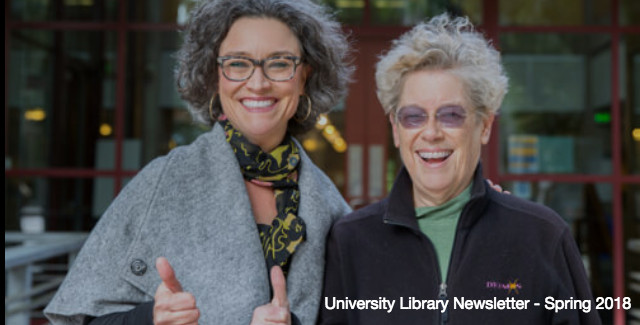
The library’s role as a space that builds community
Creating a 21st-century learning environment
A scientist by the age of five
Libraries are incubating the future
Oh, the things that Interlibrary Loan will do for our patrons!
Introducing the Undergraduate Experience Team
Coming Soon! New Library Search Tool
Exploring the Business of Being the Grateful Dead
Greetings friends:
This month, I took great pleasure in announcing a $5 million gift from an anonymous foundation to renovate the top floor of the Science & Engineering Library at UCSC. The floor will be named after Sandra Faber, the highly honored professor emerita of astronomy and astrophysics at UC Santa Cruz. It is my hope that the much-needed renovation this gift will provide will allow us to encourage and support the next generation of groundbreaking scientists, just like the one it was named after.
When the S&E Library opened in 1991, it was more than sufficient to serve the existing student population of 9,000 students. At that time, however, the internet was still in its fledgling stages, and those students did not need three or four outlets to charge multiple devices. Now, we have 18,000 students, all of whom have very different requirements for academic success than their predecessors of 25 years ago. Those students want a particular type of space, one that this generous gift will allow us to provide.
Along with EVC Marlene Tromp, I have invited key stakeholders to form a STEM-focused taskforce to decide how best to put this gift to use. This committee is led by Donald Smith, Professor of Microbiology and Environmental Toxicology, and includes Greg Careaga, a librarian whose job it is to help monitor and improve the student experience of the library. Both Careaga and Smith are interviewed in this newsletter. We also included an undergraduate and a graduate student representative on the committee, and they have completed two student surveys to make sure that the renovation truly serves current and future students’ requirements.
Those surveys showed that students are desperate for more appropriate study spaces, both quiet and collaborative. The outdated infrastructure is currently getting in the way of students doing what they need to do, so the updates we’re proposing in this phase of the renovation will provide the physical comfort and convenience needed to enhance students’ academic success.
By creating physical spaces that are both comfortable, practical, and inspiring, I hope to further our goal of making the libraries into the true heart of the UCSC campus. This process of merging society with technology to make new spaces for learning and collaborating is described later in this newsletter by Angel Dominguez, poet, former library employee, and current CITRIS administrator. Building community is a key indicator of our success as a campus because when you bring people together, connecting them with information and resources and mixing diverse populations outside of the classroom, interesting things can happen. Who knows what combination of factors and fate will inspire the next Sandra Faber?
The library is a dynamic, changing organism with three locations—two physical, one online—that supports the academic endeavor as a whole at UCSC. None of this would be possible without the people our libraries depend on, from the donors (large and small) to faculty and administrators to the student workers like Xavier Beaudet, who is interviewed later in this newsletter.
I look forward to hearing the committee’s final recommendations at the end of this quarter, and to starting work on the new Sandra Faber floor of the S&E Library. I will provide further updates in our next edition of the newsletter. Until then, please continue to support your libraries here at UCSC.
Best w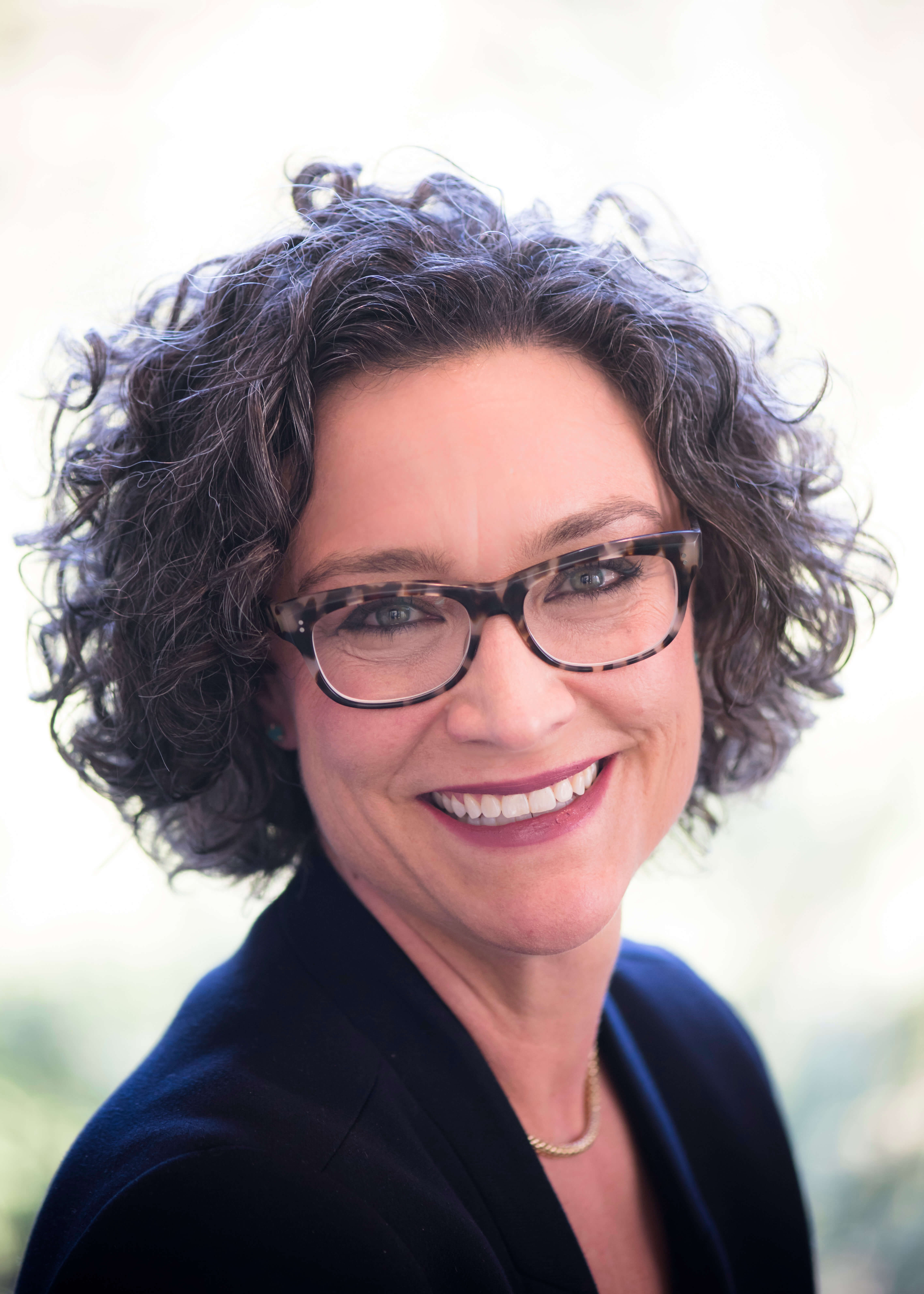 ishes,
ishes,
Elizabeth Cowell
Richard L. Press University Librarian
Presidential Chair
The library’s role as a space that builds community
Professor Donald Smith has fond memories of going to his local library as he was growing up in Monrovia, California. Even as a kid, he says, he used the library as a study space separate from his home environment. Later on, in graduate school, he remembers spending hours in the university library, poring through abstracts of published papers to find one or two that were key to the research he was doing. The elation he describes on finding the single essential piece in a sea of research is a feeling that he will never forget.
 Today, Professor Smith hopes to help his fellow faculty and a new generation of students accomplish that same “aha!” moment in the digital age. Smith, who teaches in the Microbiology and Environmental Toxicology Department, is head of a University Librarian and Campus Provost and Executive Vice Chancellor-appointed taskforce to make recommendations for the renovation of the Science & Engineering Library. He says the committee faces a difficult choice: how can this space best serve our research and teaching mission? The committee is looking at the space to see how it can be optimized to best serve student and faculty needs, both now and into the future.
Today, Professor Smith hopes to help his fellow faculty and a new generation of students accomplish that same “aha!” moment in the digital age. Smith, who teaches in the Microbiology and Environmental Toxicology Department, is head of a University Librarian and Campus Provost and Executive Vice Chancellor-appointed taskforce to make recommendations for the renovation of the Science & Engineering Library. He says the committee faces a difficult choice: how can this space best serve our research and teaching mission? The committee is looking at the space to see how it can be optimized to best serve student and faculty needs, both now and into the future.
As head of the committee, Smith has read reports from universities all over the country that are exploring similar questions. He says their mission is an exciting one, as the library is one of the few buildings on campus that serves everybody, so it should be a true hub for learning and discovery. That used to be the case because the library was where the books were, but now that most of the books and journals are easily available online, how do you use this same space to further that core mission? And how do you meet the needs of the current student population while anticipating future technological changes?
The answer is to make the changes as broad and flexible as possible. We are looking at a longer-term evolution of the library and its mission here, says Smith—and many academic libraries are undergoing a similar transformation as they adjust to the digital age and new methods of learning and research. Crucial to this transformation is the library’s role as a space that builds community by bringing together students and faculty and providing a blank canvas for their work.
To fulfill this mission, Smith says that the recent $5M gift to renovate the upper level of the library will be used to create a welcoming environment that serves a diverse set of learning and teaching needs. To do this—and to keep its future uses flexible—it is essential to bring the infrastructure of the library itself up to date. We take these basics for granted, Smith says, but they’re essential to creating the comfortable, functional environment needed for academic innovation to take place.
For Professor Smith, the challenge of creating lasting, relevant change for the library is why he agreed to head the task force. Spearheading their decisions allows him to be involved both in shaping the long-term vision for the library and in making that vision a reality. It will be a long process, Smith says, but again, design flexibility is key. He envisions modularizing the space so it can evolve and be repurposed to serve its constituents’ future needs. A café, he says, is also on the long-term wish list, which would serve to further cement the library as a central location for students to eat and meet without having to leave campus.
The key, Smith says, is to shape the library renovation around the current generation of students and faculty in ways that will use developing technologies to work for them, not limit them. Therein lie the challenge and the promise both for the library and for the university as a whole.
Creating a 21st-century learning environment
 Greg Careaga, Head of Assessment and Planning at McHenry Library and himself an alumnus of UCSC, leads the library’s Undergraduate Experience Team (UET).
Greg Careaga, Head of Assessment and Planning at McHenry Library and himself an alumnus of UCSC, leads the library’s Undergraduate Experience Team (UET).
The mission of the UET is to “foster undergraduate support and success” by providing information services and research assistance (either at the reference desk itself, via email, or through a 24-hour-a-day chat program staffed by librarians across several time zones), assessing library services for undergraduates, developing new tools to help undergraduates develop information literacy skills, and addressing the library needs of underserved populations, including international, first-generation, underrepresented minority, and undocumented students.
Careaga was on the building committee that programmed the McHenry Library addition and renovation project. He has applied that experience to early work to plan for the renovation of the Science & Engineering Library. He currently represents the library on a task force formed by Campus Provost and Executive Vice Chancellor Marlene Tromp and University Librarian Elizabeth Cowell to advise the them on how the library might best proceed with the renovation of that library. The work of the task force is timely, especially in light of a recent $5 million gift to renovate the upper level of the Science & Engineering Library and to name it in honor of Dr. Sandra Faber, Professor Emerita of Astronomy and Astrophysics, and one of UCSC’s most distinguished scholars.
Careaga says that the top floor of the Science & Engineering Library is a great opportunity to do something meaningful to improve the library experience for STEM students. Although the particulars have not yet been decided, there are a few “easy wins,” he says. For example, the existing carpets have been in place since the building was constructed in 1991. Replacing those would be a big aesthetic improvement.
Another of Careaga’s goals for the renovation is to emphasize variety and “better zoning” for study spaces so that those who want quiet or active study environments will find a place that suits them. Students’ needs do not remain static over the course of a quarter, or even a day, and sometimes they will want to move from an active learning area to a quieter one, or vice versa. Also, some people are more susceptible to auditory or visual distractions, so an environment that is conducive to concentration for one may be unsuitable for another. Staying focused on the diversity of student and faculty needs is key to developing a program for a successful renovation.
Today’s students (not surprisingly) are far more plugged-in than they were when the library was built twenty-seven years ago. This generous gift will give the library the opportunity to bring desperately needed AC and USB power points to student study spaces. It may also help the library with data and other infrastructure that could support evolving technologies and future needs.
Overall, Careaga hopes that the changes made possible by this generous $5 million gift will enhance the academic experience and create a 21st-century learning environment that will serve the campus community well for years and even decades to come.
A scientist by the age of five
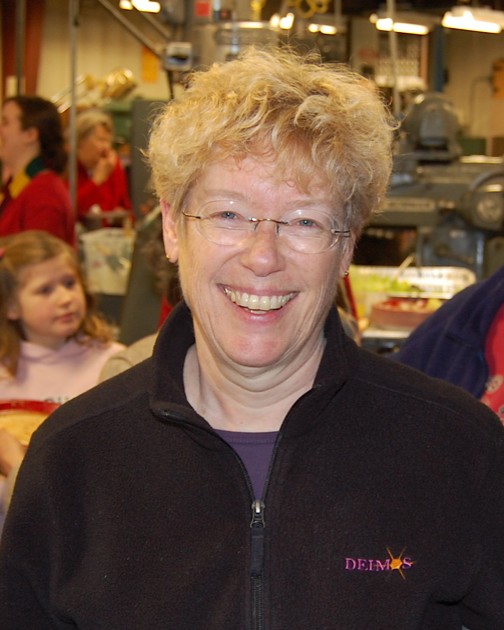 Growing up as a child in Boston, Massachusetts, Dr. Sandra Faber says she was “already a scientist” by the age of five. She had a microscope and binoculars and would lie on the lawn on summer nights and look up at the Milky Way, marveling at the expanse of it. Little did she know that it was the parts of the universe that were not shining down on her that would eventually make her career.
Growing up as a child in Boston, Massachusetts, Dr. Sandra Faber says she was “already a scientist” by the age of five. She had a microscope and binoculars and would lie on the lawn on summer nights and look up at the Milky Way, marveling at the expanse of it. Little did she know that it was the parts of the universe that were not shining down on her that would eventually make her career.
Inspired by the universe—“ which I knew nothing about,” she says—she applied to Swarthmore College in Pennsylvania. In her application, she was required to write an essay answering the question, “What would you do with a Swarthmore education?” Faber responded that she wanted to study where the universe came from, but she didn’t know how to go about doing so. Should she study it in the large (astronomy) or the small (the fundamental underpinnings of the universe, i.e., chemistry)?
Swarthmore (who accepted her application) had a telescope at their Peter van de Kamp Observatory. Faber started working at the observatory while also taking chemistry classes, which as it turned out, she didn’t like. Her dilemma solved, she decided to study the universe in the large.
After going on to do a doctorate at Harvard, Faber came to UC Santa Cruz in 1972, where she became the first-ever female staff member at the Lick Observatory. Along with graduate student Robert Jackson, she discovered what is now called the Faber–Jackson relation, which allows us to infer the distance to an elliptical galaxy based on a correlation between the observed speed of its stars and their intrinsic luminosity.
The work that was to make Faber famous, however, came in 1979, when she and John S. Gallagher were asked to write a review of the existing data on dark matter. Earlier that decade, there had been a breakthrough speculating that there was more mass to galaxies than we could see, creating a spherical shape rather than the flattened disk astronomers had always assumed galaxies took.
With the advent of radio telescope technology, astronomers could detect and measure hydrogen in far-off galaxies. As it turned out when you look at a galaxy, you see only the stars—the “bright” matter, shining down on telescopes and five-year-old girls alike—but there’s also hydrogen extending much further out at the edges of the galaxy. By measuring the rotation speed of these galaxies, you’d expect to see a decline at the outer edges based on the visible mass alone, but there wasn’t. The light was declining, but the matter itself remained constant.
Dr. Faber was asked to synthesize these findings, observed first by Albert Bosma in the Netherlands and later expanded upon by Vera Rubin, Faber’s mentor. She not only summarized their research but also made a formal conclusion affirming the existence of dark matter in the universe, which up until then many scientists had doubted because of the difficulties inherent in measuring it. As she stated on looking back at the journal review in question, “It was the only time I’ve ever written the word ‘coda.’”
To Faber, this method of building on and inferring from the work of others illustrates the magic of Western science. Opening the journal to the extensive list of references she had to provide to back up her conclusions, she says the beauty of the scientific process is that you have to use references to document the intellectual history of the subject. Furthermore, you are obliged to mention contradictory trains of thought, and then to either pursue both of them or choose one and state why you did so. Peer review is also invaluable to this approach, wherein your work is validated and confirmed by those in the same field. For these reasons, Faber describes astronomy as “one giant detective story,” as you never know when a discovery in a seemingly unrelated area will lead you to totally different conclusions in your own.
It is in this spirit that Dr. Faber hopes that her eponymous floor of the Science & Engineering Library will bring students and faculty together in ways that will “light a match” to make great things happen. She says the key here is to empower the students, to “enhance student-to-student connections and student-to-world connections.”
Overall, Dr. Faber feels great joy and gratitude for working at UC Santa Cruz. She says it has been a “very encouraging place to do work in astronomy,” with its world-class telescopes and facilities, great colleagues, and highly cooperative academic atmosphere. She feels privileged to be here, where she continues to do research and to inspire the next generation of people seeking to better understand the universe.
Libraries are incubating the future
“This is the best library in the world… show me another library where you’re at eye level with redwood trees. I’m about continuing the mission of Dean McHenry. I would do anything to help move that forward… the libraries are really taking the charge on that, elevating the community of UCSC as a whole.”
So says Angel Dominguez, Administrative Manager and Project Coordinator for CITRIS and the Banatao Institute at the 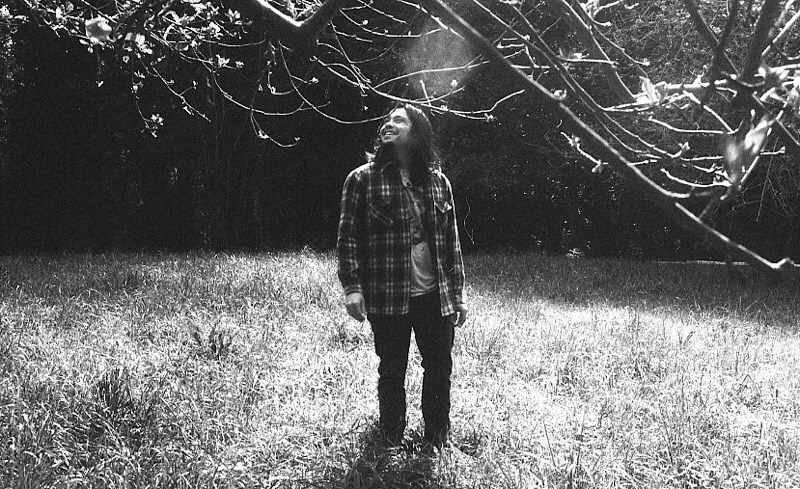 Jack Baskin School of Engineering. Dominguez is not your typical engineering staff member, however. He has an MFA in Writing and Poetics from the Jack Kerouac School of Disembodied Poetics at Naropa University in Boulder, Colorado, and has published an experimental lyric novel named Black Lavender Milk.
Jack Baskin School of Engineering. Dominguez is not your typical engineering staff member, however. He has an MFA in Writing and Poetics from the Jack Kerouac School of Disembodied Poetics at Naropa University in Boulder, Colorado, and has published an experimental lyric novel named Black Lavender Milk.
He is also a graduate of UC Santa Cruz, where he majored in Creative Writing and worked in the Development Office of the library after graduation. During the summer, he remembers, he would take his laptop and go work in the stacks, running his hands over the spines as he walked along the rows of books, “touching all that information I’d never be able to accumulate in my own body.”
When he returned to Santa Cruz after receiving his MFA—he couldn’t live in a landlocked state, he says—he looked around for a while before settling on the job with CITRIS, the Center for Information Technology Research in the Interest of Society (CITRIS). Those last two letters were what got him because he believes technology should be used in the interest of society.
Since returning to UCSC, Dominguez has been instrumental in creating a collaboration between CITRIS and the University Library in the form of the VizWall, “a 14'x4' screen installation that enables large-scale presentation of visual materials or simultaneous interaction with multiple pieces of digital content. This installation will offer the entire campus community space to visualize their research and opportunity to create interactive digital media.” The VizWall is part of the David Kirk Digital Scholarship Commons (DSC), which allows students to experiment and grow their skills with digital software and tools in a course-agnostic setting.
To Dominguez, the VizWall embraces a “reimagining of the potential of a classroom” at the forefront of a larger integration of technology and libraries. The DSC, he says, is leading the charge in what libraries can be: “community and unity; collaboration and innovation.” Libraries are “incubating the future,” and that’s where technology comes into play, especially with our proximity to Silicon Valley. These types of collaborations will open far more doors for the university and its students—for example, in industry internships. He sees an “unlimited potential” for what can happen if libraries embrace technology, and hopes that CITRIS will be integral to this process.
For his part, Dominguezl is grateful that this collaboration between CITRIS and the library has reconnected him to McHenry. He describes the library as the beating heart of the university, a living laboratory. It’s no longer just a repository for archives, and it’s not just a place where technology makes scholarly work easier. It’s become a hub, a meeting spot, a catalyst for change, creation, and innovation. And in that way, the University Library is indeed helping UCSC fulfill Dean McHenry’s vision of a leading light among the redwood trees.
Oh, the things that Interlibrary Loan will do for our patrons!
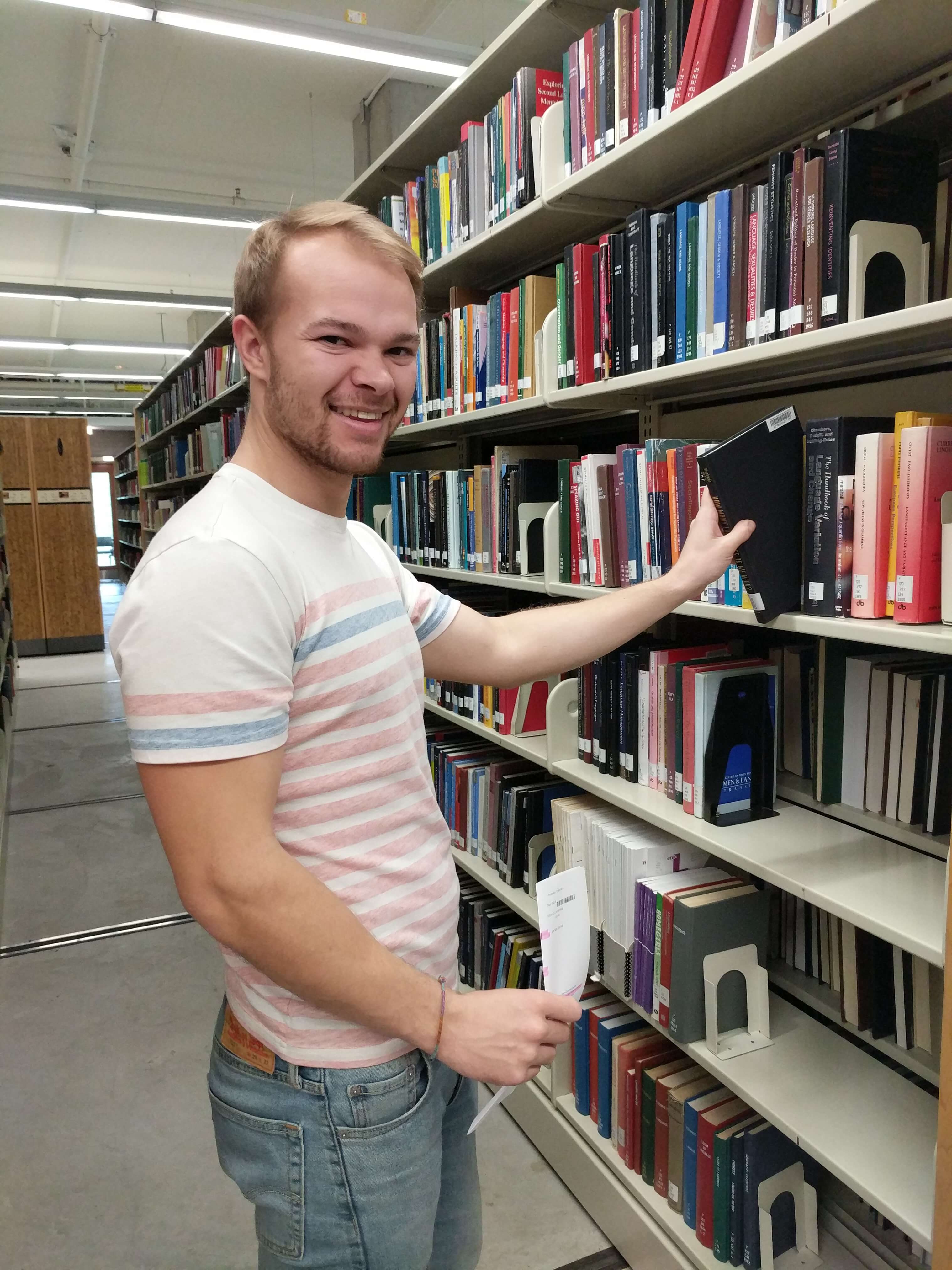 When Xavier Beaudet started working at the Interlibrary Loan (ILL) desk three years ago, he had no idea what it was. As a freshman in his first year at UCSC, he had not had much opportunity to use the services of ILL, which mostly serves graduate students and professors doing research. But, he says, working at ILL has made him realize what a crucial resource it is for graduate students, faculty, and undergraduates alike.
When Xavier Beaudet started working at the Interlibrary Loan (ILL) desk three years ago, he had no idea what it was. As a freshman in his first year at UCSC, he had not had much opportunity to use the services of ILL, which mostly serves graduate students and professors doing research. But, he says, working at ILL has made him realize what a crucial resource it is for graduate students, faculty, and undergraduates alike.
In his job at ILL, he is supervised by Tyler Green, whom he says is a great manager. He has really enjoyed his job, in which he sorts materials received from other universities all over the world, sends out emails to patrons to let them know their materials have arrived, and pulls books that McHenry holds in its archives to ship to other universities.
When asked about a recent ILL request that stands out in his mind, Beaudet told the following story:
A McHenry Library patron recently requested a book that is only available at one library in the world in France (it is basically their major library where they hold a vast variety of books, similar to the Library of Congress in the US). We contacted them for the request, and they replied completely in French. We are currently working on decoding that message so that we can get this book. Oh, the things that Interlibrary Loan will do for our patrons!
Through his work at the library, Beaudet has learned about all the other resources that UCSC has to offer, including free online databases with access to millions of articles. Again, he says that many undergraduates are not aware of these resources, and he spreads the word to all his friends. He points out too that you can even check out an Xbox and games, or play music on a keyboard in the digital commons area at the ground level of the library.
In addition, he says that recent renovations have made the library into a vibrant meeting place for students, with the café and study rooms providing places for people to either be social or have privacy. He says that both libraries have become a great community center for the campus, a true “home away from home.”
Introducing the Undergraduate Experience Team
Richard L. Press University Librarian Elizabeth Cowell established the Undergraduate Experience Team (UET) in the summer of 2014 to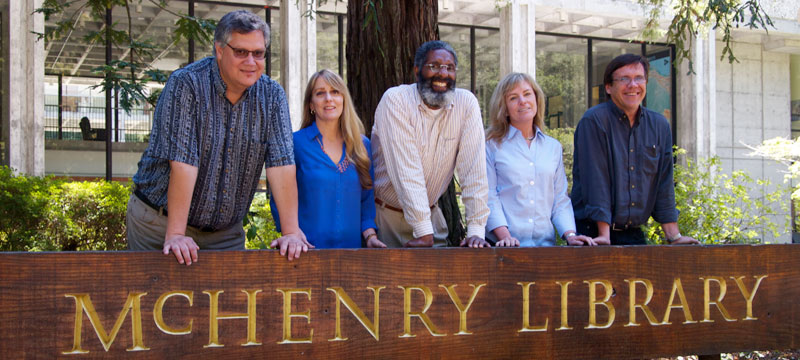 enhance library programs and services in support of UCSC undergraduates. The team provides information and research assistance to undergraduates, conducts assessments of library services for undergraduates, develops innovative tools to cultivate undergraduate research and critical thinking skills, and builds collaborative relationships with other campus stakeholders invested in undergraduate student success. In this new column for the University Library Newsletter, UET members will share news about the library’s services and resources in support of our UCSC undergraduates.
enhance library programs and services in support of UCSC undergraduates. The team provides information and research assistance to undergraduates, conducts assessments of library services for undergraduates, develops innovative tools to cultivate undergraduate research and critical thinking skills, and builds collaborative relationships with other campus stakeholders invested in undergraduate student success. In this new column for the University Library Newsletter, UET members will share news about the library’s services and resources in support of our UCSC undergraduates.
We are excited about several events we’re planning for spring quarter. UET, on behalf of the University Library, is co-sponsoring programs with three of our ca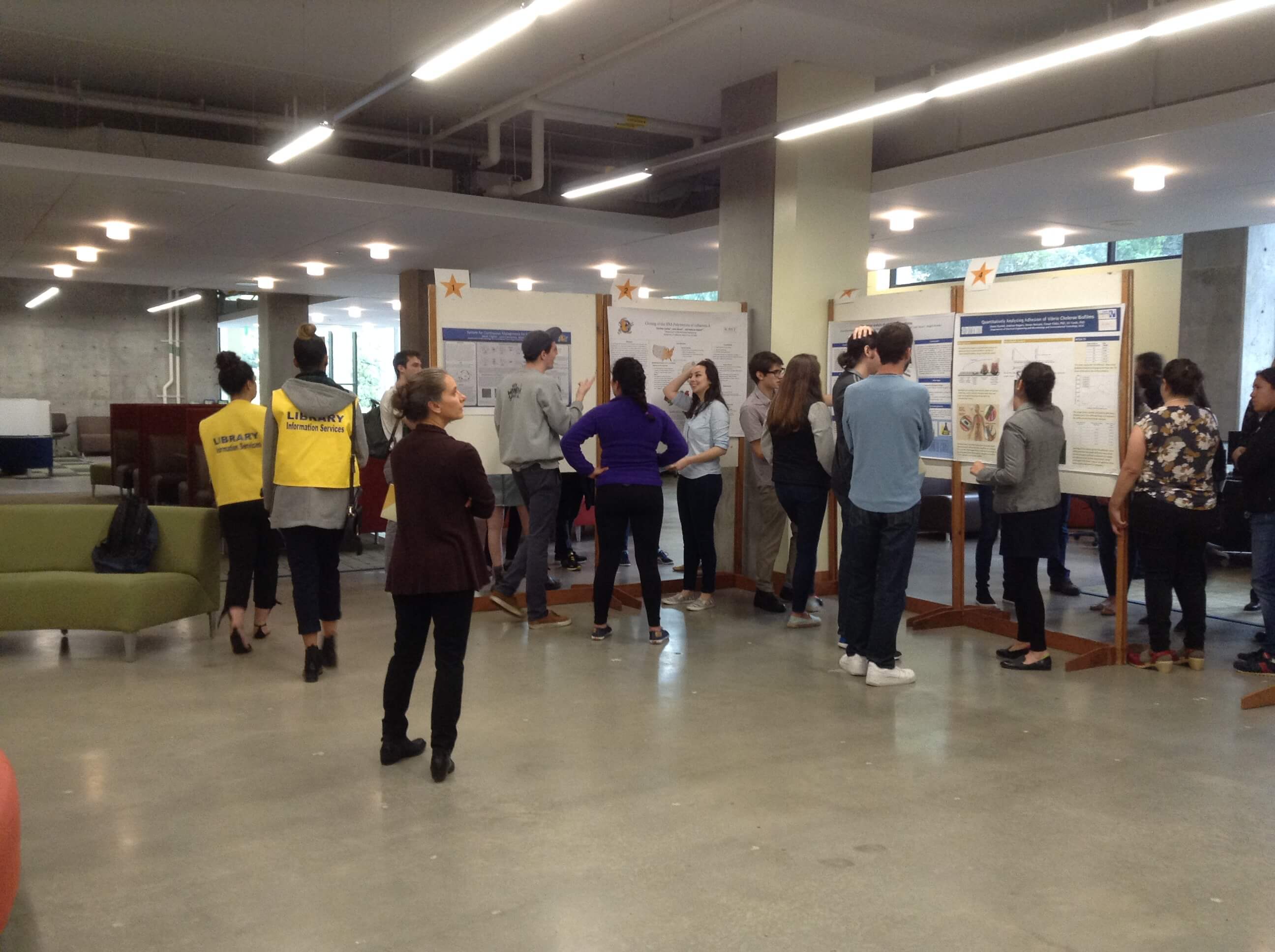 mpus student stakeholder partners: the Cultivamos Excelencia program, the Koret Scholars Program, and the Chancellor’s Undergraduate Internship Program (CUIP). Each of these events will be a poster session presenting an opportunity for undergraduates to share the fruits of their research projects. These projects include wonderfully engaging displays of academic rigor and creative scholarship, delving into a wide range of topics across disciplines in the sciences, arts, social sciences, and humanities. Anyone is welcome to attend the programs, which will all be located in McHenry Library and are scheduled to take place during Student Success Week in early June 2018. More details will be posted to the library events calendar and home page as they become available. We hope you can join us for them.
mpus student stakeholder partners: the Cultivamos Excelencia program, the Koret Scholars Program, and the Chancellor’s Undergraduate Internship Program (CUIP). Each of these events will be a poster session presenting an opportunity for undergraduates to share the fruits of their research projects. These projects include wonderfully engaging displays of academic rigor and creative scholarship, delving into a wide range of topics across disciplines in the sciences, arts, social sciences, and humanities. Anyone is welcome to attend the programs, which will all be located in McHenry Library and are scheduled to take place during Student Success Week in early June 2018. More details will be posted to the library events calendar and home page as they become available. We hope you can join us for them.
The University Library and the Undergraduate Experience Team are committed to the success of our undergraduate community, especially in support of the “discovery of new information and its synthesis into new knowledge.” We look forward to sharing more stories about the many ways we do that in future issues of the University Library Newsletter.
Coming Soon! New Library Search Tool
This summer, the University Library will be launching a new search tool that will enable users to search across the Library’s diverse resources via a single search box on the Library home page. Associate University Librarian for Collections and Services Kerry Scott spearheaded the charge to modernize library discovery. “I’m really excited about this opportunity to reveal more of our collections to our campus community. We’ve never had anything like this in the Library.” First-time users will find the new search interface intuitive and easy to use with many new features including article recommendations and advanced options. The new search tool will replace our 18-year-old catalog CruzCat.
This change is part of a wider library migration to the Ex Libris cloud-based Alma system for managing Library collections and workflows. Library staff evaluated a variety of systems before choosing Alma, which will allow for better control of library holdings, increased library efficiency and integration with other campus systems, robust analytics, and an improved discovery experience for our users.
The new search tool will be live on July 30th, 2018. To get a sneak peak at what it will look like, you can explore the Library Search for UC Santa Barbara, which recently implemented the same system (http://bit.ly/UCSBsearch). In addition, three other UC libraries have or will be migrating to this system within the year.
Upcoming Exhibits
 This spring, the graduate student fellows in the Center for Archival Research and Training (CART) will curate an exhibit showcasing the organizational records of Other Minds, a Bay Area music non-profit devoted to promoting new and experimental music from around the world. CART Fellows Madison Heying and Jay Arms are both Ph.D. candidates in Cultural Musicology and were involved in organizing, describing, and preserving the organizational records of Other Minds, including early administrative files, planning documentation for the annual OM Festival and other events, photographs, marketing materials, scores, correspondence, and artists’ biographical files. The archival collection will be available for research beginning this summer in Special Collections and Archives.
This spring, the graduate student fellows in the Center for Archival Research and Training (CART) will curate an exhibit showcasing the organizational records of Other Minds, a Bay Area music non-profit devoted to promoting new and experimental music from around the world. CART Fellows Madison Heying and Jay Arms are both Ph.D. candidates in Cultural Musicology and were involved in organizing, describing, and preserving the organizational records of Other Minds, including early administrative files, planning documentation for the annual OM Festival and other events, photographs, marketing materials, scores, correspondence, and artists’ biographical files. The archival collection will be available for research beginning this summer in Special Collections and Archives.
The exhibit featuring materials from the Other Minds collection will open on Thursday, May 10th and will be on display through July 30th, 2018, on the Third Floor Gallery of McHenry Library. A digital companion exhibit will also be available to view on the library’s website. More information forthcoming — stay tuned!
Exploring the Business of Being the Grateful Dead
Special Collections & Archives staff archivists and CART Fellows recently completed the processing of the busines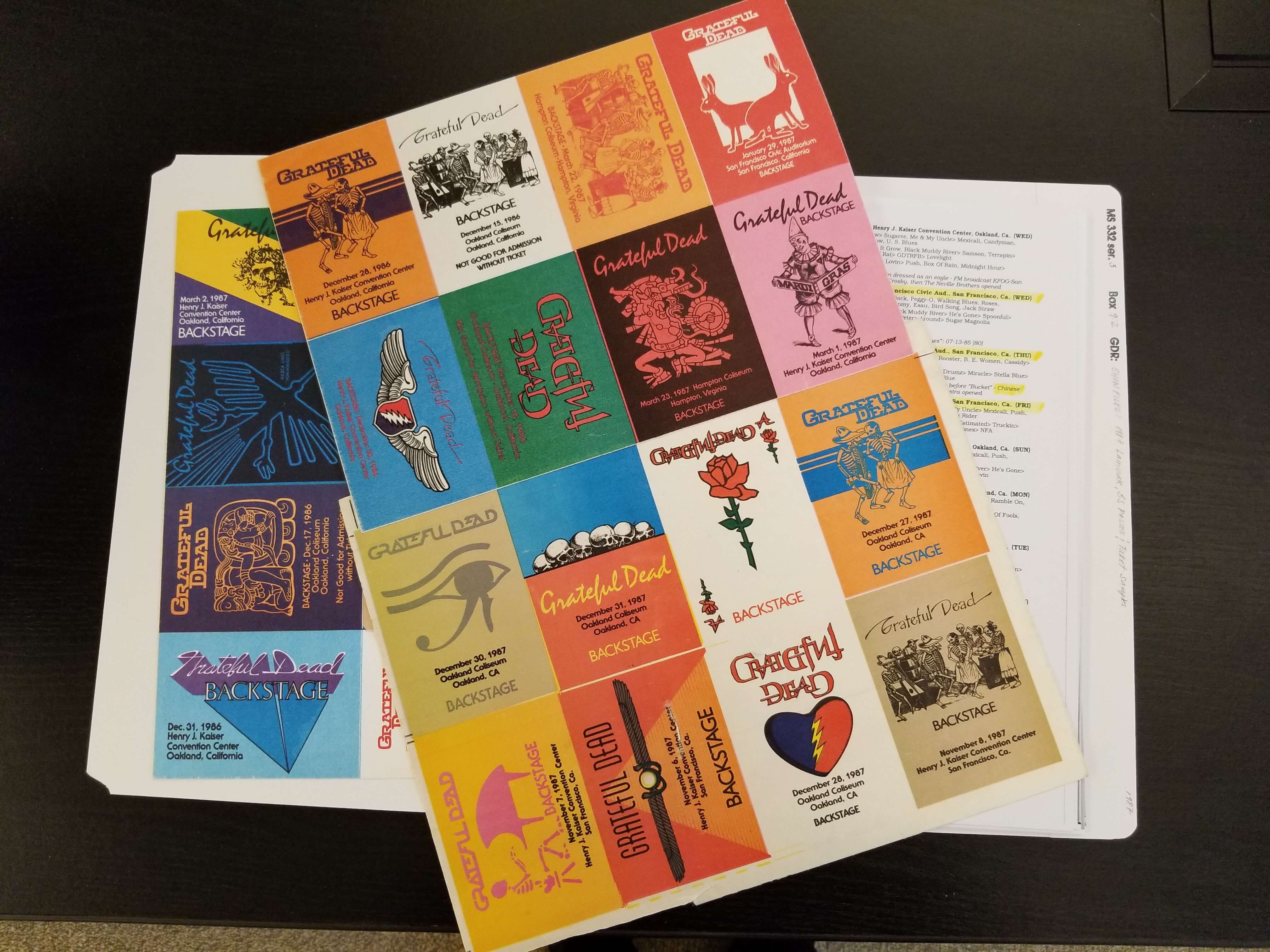 s records of the Grateful Dead. Now ready for researchers (and described here), these financial documents—which include the band’s production and promotion files, office and legal files, related correspondence, and a lot of Deadhead related materials too—fill over 150 boxes. The Library’s next exhibit, Put Your Gold Money Where Your Love Is, Baby: Counterculture & Capitalism, will draw on these materials to share just some of the many stories waiting to be told via this portion of the band’s archive.
s records of the Grateful Dead. Now ready for researchers (and described here), these financial documents—which include the band’s production and promotion files, office and legal files, related correspondence, and a lot of Deadhead related materials too—fill over 150 boxes. The Library’s next exhibit, Put Your Gold Money Where Your Love Is, Baby: Counterculture & Capitalism, will draw on these materials to share just some of the many stories waiting to be told via this portion of the band’s archive.
This exhibit will explore how the Grateful Dead invented, redefined, and pioneered business practices that revealed new ways of thinking about work, about being in business, and about the relationship between creators and their communities. Put Your Gold Money Where Your Love Is, Baby opens on June 11th in Dead Central, the exhibit gallery on the main level of McHenry Library.
Remember, there’s still time to see the current exhibit, Love On Haight: The Grateful Dead and San Francisco in 1967. It is open through May 1st.
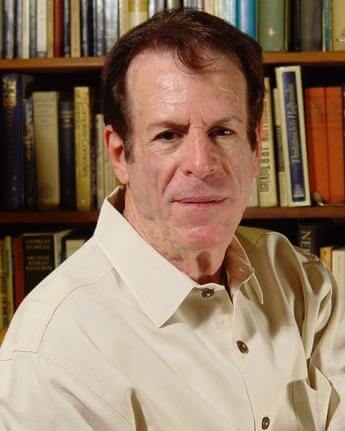 This newsletter is dedicated to the memory of Mark Engel, April 16, 1949 - December 16, 2017.
This newsletter is dedicated to the memory of Mark Engel, April 16, 1949 - December 16, 2017.
Mr. Engel was loved by many on campus, especially the library staff.
For almost ten years he was our de facto Editor-In-Chief for this newsletter. Mark will forever be remembered as a dear friend and supporter of the UCSC Library. He will be missed.
Have you inclu ded the Library in your estate plan? Please Let Us Know if the University is part of your will or trust so we can ensure that your future donation is honored, and your legacy lives on, in the precise manner you wish. All you have to do is tell us!
ded the Library in your estate plan? Please Let Us Know if the University is part of your will or trust so we can ensure that your future donation is honored, and your legacy lives on, in the precise manner you wish. All you have to do is tell us!
Drop us a line today at gift.planning@ucsc.edu or give us a call at (831) 459-1045.
Contributors: Elizabeth Cowell, Zoe Quinton, Jessica Pigza, Alix Norton, Frank Gravier, Katharin Peter, Linda Hunt and Joop Rubens
Production: Linda Hunt
Copyediting: Greg Careaga
Photography: Linda Hunt, Tara Gooden, Jessica Pigza, Carolyn Lagattuta and Alix Norton
Other Images credits: Angel Dominguez- Tatiana Luboviski-Acosta


 Santa Cruz, CA
Santa Cruz, CA



